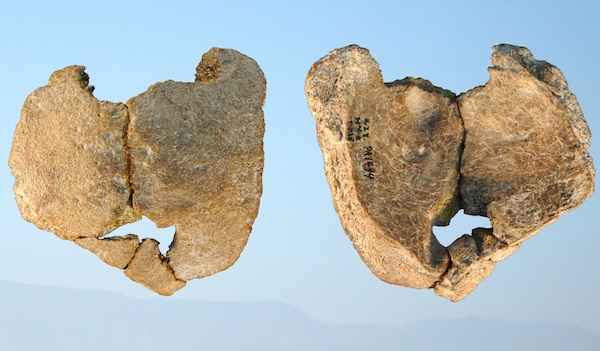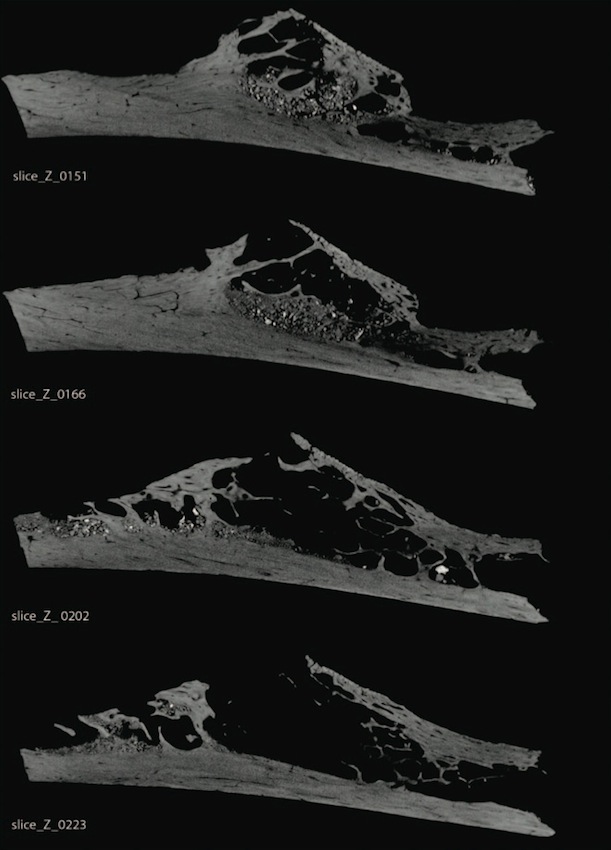Prehistoric Human Skull Shows Signs of Inbreeding
A 100,000-year-old skull has a hole that reflects genetic mutations from inbreeding—likely a common behavior for our ancestors
![]()

The hole in the top of this 100,000-year-old skull from China, researchers say, reflects genetic mutations that result from inbreeding. Image via PLOS ONE/Wu et. al.
In 2010, the surprising discovery that Neanderthals likely crossbred with our ancestors tens of thousands of years ago generated headlines around the world.
Now, we have a new finding about the sex lives of early Homo sapiens: It looks like they engaged in some inbreeding as well.
That is the conclusion of anthropologist Erik Trinkhaus of Washington University in St. Louis and Xiu-Jie Wu and Song Xing of the Chinese Academy of Sciences’ Institute of Vertebrate Paleontology and Paleoanthropology, based on a fractured 100,000-year-old skull excavated from China’s Nihewan Basin. Their finding, published yesterday in PLOS ONE, is that the skull shows evidence of an unusual genetic mutation that is likely the result of high levels of inbreeding.
The researchers used CT scanning and 3D modeling to join together for the first time the 5 pieces of the fractured skull—known as Xujiayao 11, named for the site where it was found back in 1977—and realized that it exhibited an unusual deformity. When the pieces are combined, they leave a hole on the crown of the skull, but there is no evidence that the fracture was caused by a traumatic injury or disease. As a result, they consider it most likely that the hole is a defect known as an enlarged parietal foramen.

The researchers use CT scans and 3D modeling to piece together the fractured skull for the first time. Image via PLOS ONE/Wu et. al.
Nowadays, this hole is mostly found in people with a particular pair of genetic mutations on chromosomes 5 and 11—most often a consequence of inbreeding—and occurs in about 1 of 25,000 live births. The mutation interferes with bone formation in the skull over the first five months of an infant’s life, when the pieces of the skull are supposed to fuse together to cover up the “soft spot.”
Given the tiny sample size of human skulls this old and the fact that similar kinds of genetic abnormalities have been seen so often in other prehistoric skulls—the researchers count 22 individuals with skull deformities discovered from this era—Trinkhaus thinks the simplest explanation is that small and unstable human populations forced our ancestors to inbreed.
If no inbreeding occurred, “the probability of finding one of these abnormalities in the small available sample of human fossils is very low, and the cumulative probability of finding so many is exceedingly small,” he said in a press statement. “The presence of the Xujiayao and other Pleistocene human abnormalities therefore suggests unusual population dynamics, most likely from high levels of inbreeding and local population instability.”
Such inbreeding was likely inevitable, given that most of humanity likely lived in small, isolated populations for most of our species’ evolution. For example, some scientists believe that an earlier population bottleneck that predated this skull may have driven the worldwide human population to as low as 2,000 individuals, at times making inbreeding a necessity. Our ancestors certainly didn’t understand the importance of genetic diversity and the dangerous consequences of inbreeding. But with such a scant population, the survival of our species might actually have depended on our ancient grandmothers procreating with their male relatives.
The good news? The researchers say that the genetic deformity preserved in this skull as a result of inbreeding may not have been too detrimental for this individual. Normally, it’s linked with major cognitive problems, but that’s doubtful in this case, given the demanding conditions of surviving in the Pleistocene. This prehistoric human appears to have survived to a ripe old age—which, in those days, probably means the individual lived into his or her thirties.
/https://tf-cmsv2-smithsonianmag-media.s3.amazonaws.com/accounts/headshot/joseph-stromberg-240.jpg)
/https://tf-cmsv2-smithsonianmag-media.s3.amazonaws.com/accounts/headshot/joseph-stromberg-240.jpg)